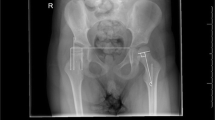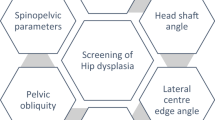Abstract
Background: Spontaneous hip lateralization complicates the management of non-ambulatory children with cerebral palsy (CP). It can be diagnosed early using radiographs, but it involves standardization of positioning and exposure to radiation. Hence, the aim of this study was to assess the utility of Combined hip abduction angle (CHAA) in the clinical setting to identify those children with CP who were at greater risk to develop spontaneous progressive hip lateralization.
Materials and Methods: One hundred and three children (206 hips) with CP formed our study population. There were 48 boys and 55 girls aged 2–11 years (mean 5.03 years). 61 children were Gross Motor Function Classifcation System (GMFCS) level 5, while 42 were GMFCS level 4. Clinical measurements of CHAA were statistically correlated with radiographic measurements of Reimer’s migration percentage (MP) for bivariate associations using χ2 and t tests.
Results: CHAA is evaluated against MP which is considered as a reliable measure of hip subluxation. Thus, for CHAA, sensitivity was 74.07% and specifcity was 67.35%. False-positive rate was 32.65% and false-negative rate was 25.93%.
Conclusions: Our study shows that correlation exists between CHAA and MP, which has been proved to be useful for hip screening in CP children at risk of hip dislocation. CHAA is an easy, rapid, cost-effective clinical test which can be performed by paraclinical health practitioners (physiotherapists) and orthopedic surgeons.
Similar content being viewed by others
References
Soo B, Howard JJ, Boyd RN, Reid SM, Lanigan A, Wolfe R, et al. Hip displacement in cerebral palsy. J Bone Joint Surg Am 2006;88:121–9.
Hägglund G, Lauge-Pedersen H, Wagner P. Characteristics of children with hip displacement in cerebral palsy. BMC Musculoskelet Disord 2007;8:101.
Bagg MR, Farber J, Miller F. Long-term follow-up of hip subluxation in cerebral palsy patients. J Pediatr Orthop 1993;13:32–6.
Samilson RL, Carson JJ, James P, Raney FL. Results and complications of adductor tenotomy and obturatorneurectomy in cerebral palsy. Clin Orthop 1967;54:61–73.
Letts M, Shapiro L, Mulder K, Klassen O. The windblown hip syndrome in total body cerebral palsy. J Pediatr Orthop 1984;4:55–62.
Eilert R, MacEwan G. Varusderotational osteotomy of the femur in cerebral palsy. Clin Orthop 1977;125:168–72.
Miller F, Girardi H, Lipton G, Ponzio R, Klaumann M, Dabney KW. Reconstruction of the dysplastic hip with peri-ilial pelvic and femoral osteotomy followed by immediate mobilization. J Pediatr Orthop 1997;17:592–602.
Castle ME, Schneider C. Proximal femoral resection-interposition arthroplasty. J Bone Joint Surg Am 1978;68:1051–4.
Root L, Siegal T. Osteotomy of the hip in children: Posterior approach. J Bone Joint Surg Am 1980;62:571–5.
Tylkowski CM, Rosenthal RK, Simon SR. Proximal femoral osteotomy in cerebral palsy. Clin Orthop Relat Res 1980;151:183–92.
Bleck EE. Orthopaedic management in cerebral palsy. London: MacKeith Press; 1987. p. 99–371, 440-70.
Koffman M. Proximal femoral resection or total hip replacement in severely disabled cerebral-spastic patients. Orthop Clin North Am 1981;12:91–100.
Palisano R, Rosenbaum P, Walter S, Russell D, Wood E, Galuppi B. Development and reliability of a system to classify gross motor function in children with cerebral palsy. Dev Med Child Neurol 1997;39:214–23.
Wood E, Rosenbaum P. The gross motor function classification system for cerebralpalsy: A study of reliability and stability over time. Dev Med Child Neurol 2000;42:292–6.
Howard CB, McKibbin B, Williams LA, Mackie I. Factors affecting the incidence of hip dislocation in cerebral palsy. J Bone Joint Surg Br 1985;67:530–2.
Lonstein JE, Beck K. Hip dislocation and subluxation in cerebral palsy. J Pediatr Orthop 1986;6:521–6.
Reimers J. The stability of the hip in children: A radiological study of results of muscle surgery in cerebral palsy. Acta Orthop Scand 1980;184:1–100.
Scrutton D. The early management of hips in cerebral palsy. Dev Med Child Neurol 1989;31:108–16.
Hägglund G, Lauge-Pedersen H, Persson M. Radiographic threshold values for hip screening in cerebral palsy. J Child Orthop 2007;1:43–7.
Beals RK. Developmental changes in the femur and acetabulum in spastic paraplegia and diplegia. Dev Med Child Neurol 1969;11:303–13.
Robin J, Graham HK, Selber P, Dobson F, Smith K, Baker R. Proximal femoral geometry in cerebral palsy: A population-based cross-sectional study. J Bone Joint Surg Br 2008;90:1372–9.
Birkenmaier C, Jorysz G, Jansson V, Heimkes B. Normal development of the hip: A geometrical analysis based on planimetric radiography. J Pediatr Orthop B 2010;19:1–8.
Gage JR, Deluca PA, Renshaw TS. Gait analysis: Principles and applications. J Bone Joint Surg Am 1995;77:1607–23.
Mutlu A, Livanelioglu A, Gunel MK. Reliability of ashworth and modified ashworth scales in children with spastic cerebral Palsy. BMC Musculoskelet Disord 2008;9:44.
Author information
Authors and Affiliations
Corresponding author
Rights and permissions
About this article
Cite this article
Divecha, A., Bhaskar, A. Utility of combined hip abduction angle for hip surveillance in children with cerebral palsy. IJOO 45, 548–552 (2011). https://doi.org/10.4103/0019-5413.87129
Published:
Issue Date:
DOI: https://doi.org/10.4103/0019-5413.87129




